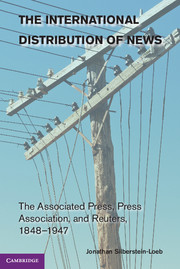 The International Distribution of News
The International Distribution of News Book contents
- Frontmatter
- Dedication
- Contents
- List of Tables
- Acknowledgments
- 1 Introduction
- 2 Conceiving Cooperation among American Newspapers, 1848–1892
- 3 Cooperation, Competition, and Regulation in the United States, 1893–1945
- 4 The “Rationalist Illusion,” the Post Office, and the Press, 1868–1913
- 5 Private Enterprise, Public Monopoly, and the Preservation of Cooperation in Britain, 1914–1941
- 6 Reluctant Imperialist? Reuters in the British Empire, 1851–1947
- 7 Cartel or Free Trade: Supplying the World’s News, 1856–1947
- 8 Conclusion
- Bibliography
- Index
- References
2 - Conceiving Cooperation among American Newspapers, 1848–1892
Published online by Cambridge University Press: 05 July 2014
- Frontmatter
- Dedication
- Contents
- List of Tables
- Acknowledgments
- 1 Introduction
- 2 Conceiving Cooperation among American Newspapers, 1848–1892
- 3 Cooperation, Competition, and Regulation in the United States, 1893–1945
- 4 The “Rationalist Illusion,” the Post Office, and the Press, 1868–1913
- 5 Private Enterprise, Public Monopoly, and the Preservation of Cooperation in Britain, 1914–1941
- 6 Reluctant Imperialist? Reuters in the British Empire, 1851–1947
- 7 Cartel or Free Trade: Supplying the World’s News, 1856–1947
- 8 Conclusion
- Bibliography
- Index
- References
Summary
John Sayward’s scoop was big news, especially in Bangor, Maine. It ran in the Saturday issue of the Whig and Courier, published February 24, 1849 and Sayward, the paper’s editor, deployed a large bold font to announce it. The “First Dispatch of Foreign News from the East!”, Sayward explained, was obtained only with considerable effort. The news from Europe, which crossed the Atlantic aboard the royal mail steamship Europa, was the first foreign news ever to pass by telegraph from St. John, Nova Scotia westward. After the Europa arrived at Halifax on the evening of February 21, a relay of horses carried the news 144 miles to Digby through a recent and heavy fall of snow, the heaviest, it was said, that had been experienced in fifty years. The news did not arrive in Digby until four o’clock the following morning. There it was delayed nearly twelve hours, a consequence of the utter impossibility of breaking a passage for a steamer through the ice with which Digby Bay was jammed. Only with the full force of the engine and paddle wheels, and with the assistance of twenty men, was a channel finally made by which the steamer could pass through the gut between Bay View and Victoria Beach, out into the Bay of Fundy, and onward to St. John, whence the news was finally telegraphed to Bangor, and thence to points south.
- Type
- Chapter
- Information
- The International Distribution of NewsThe Associated Press, Press Association, and Reuters, 1848–1947, pp. 9 - 45Publisher: Cambridge University PressPrint publication year: 2014


